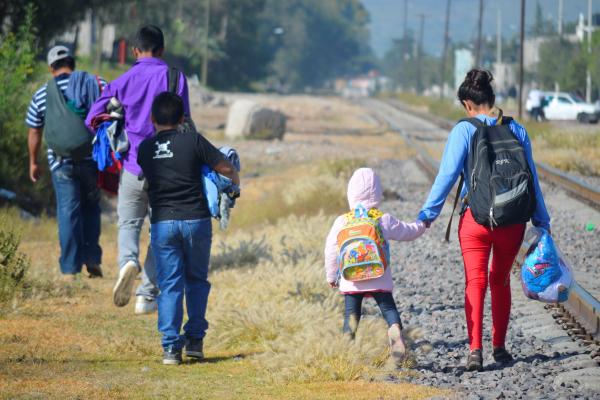In the almost complete darkness before midnight in the Caribbean Sea, a scream suddenly pierces the crash of the waves and wind.
“This is the Coast Guard. Stop your engines!”, an officer scream. Powerful flashlights reveal a 32-foot, single-engine boat, crowded with immigrants — some of them small children — lying on the floor of the vessel. They are Venezuelan nationals; the Coast Guard later establishes. The footage was provided to CNN by the Colombian government.
This scene has been repeating itself with regularity around the Colombian San Andres Archipelago, located 775 kilometers (482 miles) northwest of mainland Colombia where the Colombian Coast Guard routinely intercepts boats loaded with migrants who pay smugglers to take them across the Caribbean.
Arriving in Central American countries like Nicaragua, the trip allows the migrants to avoid the perilous Darien Gap, a jungle region in Panama at the Colombian border that is also used by migrants trekking north with the hope of eventually reaching the United States.
Colombian Marine Corps Captain Octavio Gutiérrez, who serves in the San Andrés Archipelago, says migrants fly into the islands where they spend a night or two as they try to get in touch with smugglers.
“Originally, [the smugglers] were charging between 1,000 and 1,500 dollars. Now we’re getting testimonies of people who have paid the smugglers as much as 4,000 dollars per person to be transported from San Andrés to Central America,” the captain said.
Gutiérrez says that, during the month of September, the Coast Guard confiscated 35 boats while conducting 29 operations targeting smugglers in the zone.
From the beginning of the year through the end of September, the Coast Guard has detained 14 smugglers transporting 526 migrants, including children. And the number of migrants trying to reach Central America has been steadily increasing.
From South America to the United States, trying to stop yet another wave of migrants seems to be a losing battle. As CNN reported last month, US Customs and Border Protection encounters along the US-Mexico border have already topped 2 million so far, this fiscal year, according to newly released agency data, with migration from authoritarian nations Venezuela, Nicaragua and Cuba driving numbers up.
And many migrants’ testimonies suggest, more than ever, they are willing to face any risk and pay ever increasing amounts of money to reach their American dream.
‘I’m making this sacrifice to give my children a better life’
In the span of just one week at the end of September, the Colombian Coast Guard detained 131 migrants, it told CNN. Though there were citizens from Cuba, Peru and Ecuador, most were Venezuelans, it said — an observation echoed by migration officials in other transit countries, like Panama and Guatemala.
Many are young men like Mario Mosquera and Jefferson Lozada, two Venezuelan cousins, whom CNN found walking along a highway in eastern Guatemala, told CNN that the country’s crushing economic conditions had forced them out.
“Venezuela is unlivable. The economic crisis has been very hard, and the truth is that I’m making this sacrifice to give my children a better life,” Mosquera, a married father of three, said.
“Minimum wage [in Venezuela] is not even enough for food. I left my country in search of a better future for me, for my mother and my siblings,” Lozada said.
According to a recent report by the New York-based humanitarian NGO International Rescue Committee, an estimated one-third of the population —over 9 million people — faced hunger in 2019. “While data in Venezuela is often limited or missing entirely, this figure is likely growing; 14% of all children under age 5 in Venezuela suffer from global acute malnutrition; 57% of pregnant women are malnourished,” it said.
The number of Venezuelans who have fled their country has already surpassed 7.1 million, according to the United Nations refugee agency. It surpasses countries like Ukraine (6.8 million) and Syria (6.6 million). These figures are striking because, unlike the other two nations, the South American country is not at war.
In Caracas, CNN spoke with another man who says he’s desperate to get out of Venezuela and has already decided he will leave his country for the United States. He declined to reveal his identity because he works for the government of Venezuela.
His government job pays about five dollars a week, which forces him to hold two other jobs to make ends meet, he said.
“The real question is how to get to the United States,” the 38-year-old added, saying that he has no visa for the United States, Mexico, or the Central American countries he would have to travel through.
He is well-aware of the dangers of the trip. “There are guerrillas, criminals, and wild animals in the [Darien Gap],” he says, referring to a treacherous wild stretch 266 kilometers long that routinely proves deadly to migrants — but through which thousands cross every day.
More than 134,000 northbound migrants entered Panamanian territory through the Darien Gap between the beginning of the year and the end of September, according to Panama’s Security Ministry,
But still, he points out that he already faces daily hardship and danger from armed violence in his own neighborhood. A day before his interview, two of his neighbors died in a shooting, he said. (CNN)



































